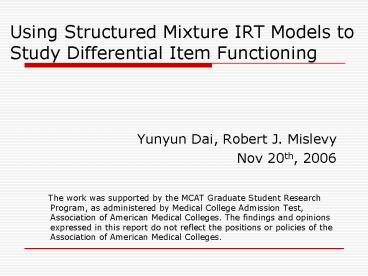Using Structured Mixture IRT Models to Study Differential Item Functioning - PowerPoint PPT Presentation
1 / 25
Title: Using Structured Mixture IRT Models to Study Differential Item Functioning
1
Using Structured Mixture IRT Models to Study
Differential Item Functioning
- Yunyun Dai, Robert J. Mislevy
- Nov 20th, 2006
- The work was supported by the MCAT Graduate
Student Research Program, as administered by
Medical College Admission Test, Association of
American Medical Colleges. The findings and
opinions expressed in this report do not reflect
the positions or policies of the Association of
American Medical Colleges.
2
Outline
- Background Knowledge of DIF Analysis
- Framework of DIF Analysis
- Structured Mixture IRT Model
- WINBUGS Code
- Model Identification
3
Definition of DIF
- Differential item function (DIF)
- is defined as item performing differently for
one group of examines from the way it performs
for another group of examinees. (Embretson
Reise, 2000) - The presence of nuisance dimensions intrudes
on the measurement of the ability of interest and
leads to the differential item functioning.
(Ackerman, 1992).
4
General Assumption on Examinees
- Homogenous Population
- Homogenous vs. Heterogeneous
- Cause of DIF
5
Potential Causes of DIF
- Demographic Characters
- (gender, ethnicity, etc.)
- Problem-solving Strategies
- (Mislevy Verhelst, 1990)
- Subcategory of Problem Types
- (Cohen Bolt, 2005)
6
Manifest Group DIF Analysis
- Manifest Group Characteristics
- Focal group vs. Reference group
- Q for Who the item function differently?
7
Latent Class DIF Analysis
- Grouping Variables are unobserved
- Group memberships are estimated based on
examinees response patterns - Q Why the item function differently?
8
Framework of DIF Analysis
9
Framework of DIF Analysis Manifest Group DIF
Analysis
- Politically oriented
- e.g., Maryland High School Assessment
10
Framework of DIF AnalysisLatent Class DIF
Analysis
- Exploratory Approach
- Confirmatory Approach
11
Structured Mixture IRT Model (1)
12
Structured Mixture IRT Model (2)
- Person covariate g
- (Math courses taken, gender group)
- Item covariate q
- (content areas, cognitive skills)
13
Structured Mixture IRT Model (3)
- Person covariate
- Q How persons covariate variables influence
examinees probability belonging to certain
latent group - Item covariate
- Q How item covariates variables affect item
difficulty
14
Specification of Persons Covariate (1)
- Gidcat( Pi, )
(1) - log(PHIi,j) lt- intj sljgenderi (2)
- Pi,jlt- PHIi,j / sum(PHIi,) (3)
- WINBUGS Constraint int10 sl10
15
Specification of Persons Covariate (2)
- Table 1 Relationship between parameters in
logistic regression and proportion of persons
covariate
16
Specification of Persons Covariate (3)
17
WINBUGS Specification
- Model
- latent group proportion and examinees' average
ability fo each latent group - for (j in 1J) P.totj lt-
sum(P,j)/N mutj dnorm(0,1) - intercept and slope in the logistic regression
function - for (j in 2J) intj
dnorm(0,1) slj dnorm(0,1) - int 1lt-0 sl1 lt- 0
- specification of item difficulty for each latent
group - for (m in 1M-1) b1,m
dnorm(0,1)b2,m lt- b1,m difm difm
dnorm(0,0.5) - b1,Mlt- -1sum(b1,1(M-1))
b2,M lt- -1sum(b2,1(M-1))
difMlt-b2,M-b1,M - latent group membership for every examinee
- for (i in 1N) Gidcat( Pi, )
gmemcat1ilt-equals(Gi,1) - latent ability distribution for every examinee
- for (i in 1N) thetaidnorm(mut
Gi,1) - logistic regression function
18
Model Identification (1)
- Identification is a challenge in IRT models,
- DIF models,
- LLTM models,
- mixture models,
- structured models with covariates
- and this research project is attempting to
combine all of these modeling ideas at once.
19
Model Identification (2)
- Label switching problem
- Chung, Loken, and Schafer (2004) suggested
assigning one observation to each component as
prior may effectively eliminate the problem.
20
Model Identification (3)
- Graph1 MCMC runs for latent class proportion
based on simulated data for stage 7 (50, 50)
21
Model Identification (4)
- Graph2 MCMC runs for latent class proportion
based on simulated data for stage 2 (30, 70)
22
Model Identification (5)
- Graph3 MCMC runs with prior information added
(the simple solution) for latent class proportion
based on simulated data for stage 2 (30, 70)
23
Model Identification (6)
- Graph 4 MCMC runs for latent class proportion
based on simulated data for stage 5 (30, 70)
24
Model Identification (7)
- Graph 5 MCMC runs for latent class proportion
based on simulated data for stage 5 (30, 70)
25
References
- Ackerman, T. A. (1992). A didactic explanation of
item bias, item impact, and item validity from a
multidimensional perspective. Journal of
Educational Measurement, 29, 67-91. - Chung, H., Loken, E., and Schafer, J. L. (2004),
"difficulties in drawing inferences with
finite-mixture models a simple example with a
simple solution," the American statistician, 58,
152-158. - Cohen, A.S., Bolt, D.M. (2005). A mixture
model analysis of differential item functioning.
Journal of Educational Measurement Sum 2005 Vol
42(2) 133-148. - Embretson, S.E., Reise, S.P. (2000). Item
Response Theory for Psychologists. Mahwah, N.J.
Lawrence Erlbaum. - Fischer, G. H. (1973). The linear logistic test
model as an instrument of educational research.
Acta Psychologica, 37, 359-374. - Mislevy, R. J., Verhelst, N. (1990). Modeling
item responses when different subjects employ
different solution strategies. Psychometrika, 55,
195-215.































